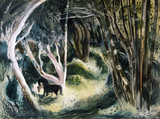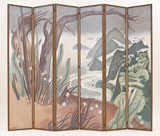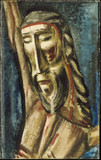Recognized as a major figure for more than five decades, Millard Owen Sheets was perhaps the best-known traditional Southern California artist of his generation. He was equally accomplished in oils, watercolors, prints, murals, and mosaics. He also was a greatly admired art instructor, teaching at Chouinard School of Art, Los Angeles, from 1929 to 1935 and associated with Scripps College, Claremont, for more than 20 years beginning in 1932, first as a professor and then as director of the art school; he also was director of Los Angeles County Art Institute (Otis Art Institute) from 1953 to 1959. From 1965 to 1975 he held painting classes in Greece, Mexico, and other exotic lands.
As a teenager Sheets received criticism from Clarence Hinkle (1880-1960) in Laguna, California, then studied with F. Tolles Chamberlin (1873-1961) at Chouinard. Immediately following his graduation from Chouinard in 1929, Sheets toured Europe and then returned to the United States to teach and participate in national exhibitions. During the 1930s Sheets assisted STANTON MACDONALD-WRIGHT and Dalzell Hatfield in managing the Works Progress Administration/Federal Art Project of Southern California, and for twenty-five years he administered the annual Fine Arts Exhibition at the Los Angeles County Fair in Pomona.
In 1929 Sheets had his first solo exhibition in Los Angeles at Newhouse Galleries and in 1934 his first exhibition in New York at Milch Galleries. He was praised for his watercolors, which were compared with those of WINSLOW HOMER. Sheets’s early mature paintings of the 1930s were scenes of Los Angeles and of the farms, ranches, and beaches of Southern California. The last named were tinged with a romanticism that later found expression in exotic subject matter. Throughout his career Sheets traveled to all parts of the world. During World War II he served as an artist-correspondent in India and in the early 1960s acted as an art representative for the United States State Department abroad.
Beginning in 1929 the artist’s sense of decorative design manifested itself most clearly in his murals. In 1953 he established a production studio, Millard Sheets Designs, Inc., to fabricate his designs for painted and mosaic murals and stained-glass windows. His success as a muralist resulted in his resigning from the Los Angeles County Art Institute. He designed murals for buildings throughout the United States; in California he is perhaps best known for his mosaic murals that embellish the facades of Home Savings and Loan Association buildings.
BIBLIOGRAPHY
Arthur Millier, Hartley B. Alexander, and Merle Armitage, Millard Sheets (Los Angeles: Dalzell Hatfield, 1935), with lists of murals, works in collections, and exhibitions § Moure with Smith 1975, p. 228, with bibliography § University of California, Los Angeles, Oral History Program, interview with the artist by George M. Goodwin, November 17,1976-February 9, 1977 § Laguna Beach (Calif.) Museum of Art and others, Millard Sheets: Six Decades of Painting, exh. cat, 1983, with essays by Susan C. Larsen and Janice Lovoos, chronology; lists of exhibitions and collections, selected bibliography § Janice Lovoos and Edmund F. Penney, Millard Sheets: One-Man Renaissance (Flagstaff, Ariz.: Northland Press, [c. 1984]), foreword by Richard Armour, with chronology; lists of murals, exhibitions, and honors.






